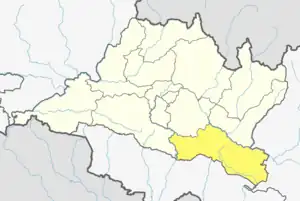Phikkal Rural Municipality
Phikkal is a Rural municipality located within the Sindhuli District of the Bagmati Province of Nepal. The municipality spans 186.06 square kilometres (71.84 sq mi) of area, with a total population of 15,910 according to a 2021 Nepal census.[1][2]
Phikkal Gaupalika
फिक्कल गाउँपालिका Phikkal | |
|---|---|
| Phikkal Rural Municipality | |
| Coordinates: 27°14′37″N 86°17′04″E | |
| Country | |
| Province | Bagmati |
| District | Sindhuli District |
| Wards | 6 |
| Established | 10 March 2017 |
| Government | |
| • Type | Local Level Government |
| • Chairperson | Mrs. Parbati Sunuwar |
| • Vice-Chairperson | Mr. Raju Baral |
| • Term of office | (2021 - 2026) |
| Area | |
| • Total | 186.06 km2 (71.84 sq mi) |
| Population (2022)Phikka Rural Municipality | |
| • Total | 15,910 |
| • Density | 86/km2 (220/sq mi) |
| Time zone | UTC+5:45 (Nepal Standard Time) |
| Postal Code | 45901 |
| Area code | 047 |
| Headquarter | Khang Sang |
| Website | phikkalmun |
| Chairmenship and vice-chairmanship is led by CPN UML political party. | |
On March 10, 2017, the Government of Nepal restructured the local level bodies into 753 new local level structures.[3][4] The previous Mahadevdada, Sunam Pokhari, Kholagaun, Khang Sang, Solpathana and Ratnawati VDCs were merged to form Phikkal Rural Municipality. Phikkal is divided into 6 wards, with Khang Sang declared the administrative center of the rural municipality.
Demographics
At the time of the 2011 Nepal census, Phikkal Rural Municipality had a population of 16,968. Of these, 58.7% spoke Nepali, 17.1% Magar, 10.9% Sunwar, 4.7% Wambule, 4.6% Tamang, 2.6% Newar, 0.5% Majhi, 0.3% Jerung, 0.3% Maithili, 0.2% Rai and 0.1% other languages as their first language.[5]
In terms of ethnicity/caste, 20.9% were Magar, 15.9% Sunuwar, 12.6% Chhetri, 11.6% Hill Brahmin, 8.4% Kami, 5.4% Sarki, 5.2% Rai, 5.1% Tamang, 5.0% Newar, 4.6% Damai/Dholi, 2.1% Gharti/Bhujel, 1.5% Majhi, 0.5% Terai Brahmin, 0.5% Sanyasi/Dasnami, 0.3% Sonar and 0.4% others.[6]
In terms of religion, 88.0% were Hindu, 6.6% Buddhist, 4.8% Kirati, 0.1% Christian and 0.3% others.[7]
In terms of literacy, 58.6% could read and write, 3.7% could only read and 37.6% could neither read nor write.[8]
References
- "District Corrected Last for RAJAPATRA" (PDF). www.mofald.gov.np. Retrieved 17 July 2018.
- "स्थानीय तहहरुको विवरण" [Details of the local level bodies]. www.mofald.gov.np/en (in Nepali). Ministry of Federal Affairs and Local Development. Retrieved 17 July 2018.
- "New local level structure comes into effect from today". www.thehimalayantimes.com. The Himalayan Times. 10 March 2017. Retrieved 17 July 2018.
- "New local level units come into existence". www.kathmandupost.ekantipur.com. 11 March 2017. Retrieved 18 July 2018.
- NepalMap Language
- NepalMap Caste
- NepalMap Religion
- NepalMap Literacy
